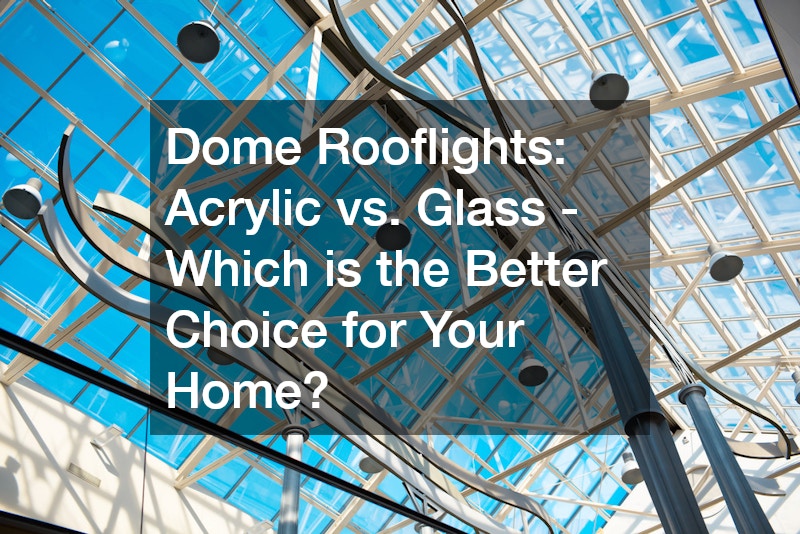Disclaimer: NC Pool Supply. This site provides home improvement content for informational purposes only.
When considering enhancements to your home that bring in natural light, dome rooflights can be an excellent option. They illuminate your living spaces and add aesthetic value to your property. However, choosing between acrylic and glass dome rooflights can be challenging, as each material has its unique advantages and drawbacks.
This article will delve into the key differences between acrylic and glass dome rooflights, helping you make an informed decision for your home.
Longevity: Acrylic vs. Glass One of the most significant differences between acrylic and glass dome rooflights is their lifespan. Acrylic dome roof lights typically last between 10 to 15 years. Over time, they can degrade due to exposure to UV rays, eventually leading to cracks. These cracks can allow water to seep in, necessitating replacement. This limited lifespan can be a disadvantage for homeowners looking for a long-term solution.
In contrast, glass dome rooflights are built to last. Just like the windows in your home or car, the quality glass will not degrade or turn yellow over the years. A well-installed glass dome rooflight can remain as effective after two decades as it was on the day of installation. This longevity makes glass a compelling choice for those who want a durable option that does not require frequent replacements.
Energy Efficiency Energy efficiency is another crucial factor to consider when selecting dome rooflights. Glass dome rooflights often come with a low-emissivity (low-E) coating. This special coating helps regulate temperature by reflecting heat back into your home during winter and blocking excessive heat during summer. This feature not only helps maintain a comfortable indoor environment but can also contribute to lower energy bills.
On the other hand, acrylic dome rooflights lack this energy-efficient technology. They allow heat to pass through without any filtration, which can result in higher heating and cooling costs throughout the year. If energy efficiency is a priority for you, glass dome rooflights are likely the better choice.
Safety and Building Codes In addition to longevity and energy efficiency, safety considerations are paramount when choosing rooflights. Glass dome rooflights are generally designed to meet energy codes and fire safety regulations, making them a safer option for many homeowners. This compliance can provide peace of mind, particularly in regions with strict building codes.
Conversely, acrylic dome rooflights often do not meet these safety standards, which may pose a risk, especially in areas prone to high temperatures or extreme weather conditions. Homeowners should consult local regulations to ensure compliance when selecting their rooflights.
Aesthetic Appeal The aesthetic appeal of dome rooflights is another factor that can influence your choice. Acrylic dome rooflights typically come in a range of colors and styles, allowing for customization. However, they may not offer the same clarity and sophistication as glass options.
Glass dome rooflights provide a sleek and modern look, enhancing the overall design of your home. The transparency and clarity of glass allow for unobstructed views of the sky, bringing a touch of elegance to any space. If aesthetic appeal is a top concern, glass dome rooflights may be the more attractive option.
Maintenance Requirements Maintenance is another critical consideration when choosing between acrylic and glass dome rooflights. Acrylic tends to be more susceptible to scratching, and the surface can become cloudy over time. This necessitates more frequent cleaning and upkeep to maintain its appearance and functionality.
In contrast, glass rooflights are generally easier to clean and maintain. Their hard surface resists scratches and maintains its clarity longer. Homeowners can expect less maintenance effort and expense over the lifespan of glass dome rooflights.
Cost Considerations While both acrylic and glass dome rooflights offer benefits, they also come with varying price points. Acrylic options are typically less expensive upfront, making them an attractive choice for budget-conscious homeowners. However, their shorter lifespan and higher maintenance costs may make them more expensive in the long run.
Glass dome rooflights, while initially pricier, often provide better long-term value due to their durability, energy efficiency, and lower maintenance requirements. Homeowners should consider the total cost of ownership over time rather than just the initial investment.
Conclusion Choosing the right dome roof lights for your home involves weighing the pros and cons of acrylic versus glass. Acrylic dome rooflights may be more budget-friendly upfront, but their shorter lifespan and lower energy efficiency can make them less desirable in the long run. On the other hand, glass dome rooflights offer durability, energy efficiency, and aesthetic appeal, making them a sound investment for those looking for a long-lasting solution.
Ultimately, the best choice will depend on your specific needs, budget, and preferences. By understanding the differences between these two materials, you can make a well-informed decision that enhances your home’s natural light while ensuring safety and efficiency for years to come.
.

